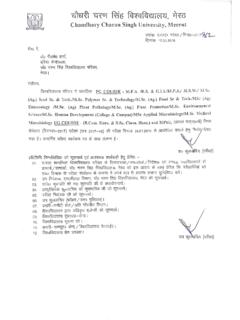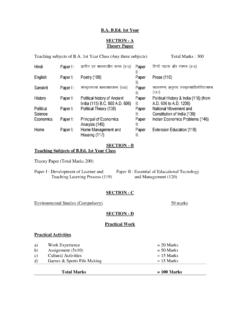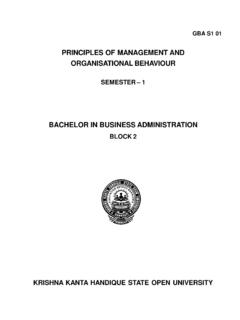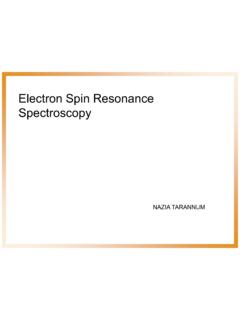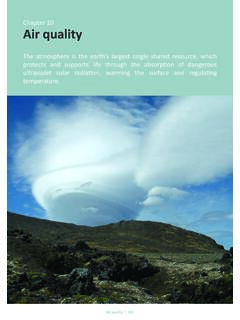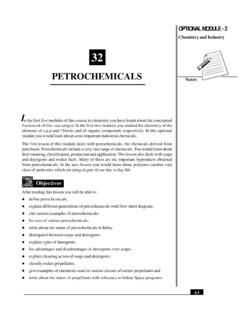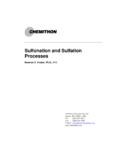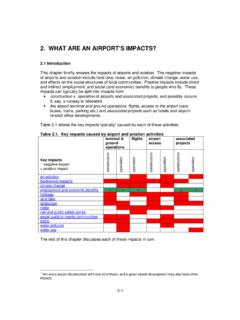Transcription of Phase Rule CHAPTER-6 PHASE RULE
1 See discussions, stats, and author profiles for this publication at: Rule CHAPTER-6 PHASE RULEC hapter October 2010 CITATION1 READS93,3871 author:Some of the authors of this publication are also working on these related projects:Advanced carbon materials View projectSyed Shabudeen College of Technology193 PUBLICATIONS 225 CITATIONS SEE PROFILEAll content following this page was uploaded by Syed Shabudeen on 15 September user has requested enhancement of the downloaded Rule A PHASE is defined as any homogeneous and physically distinct part of a system bounded by a surface and is mechanically separable from other parts of the system.
2 A PHASE may be gaseous , liquid or solid. It is perfectly homogeneous and distinct from every other PHASE that is present in the must be a definite boundary between any two phases. This boundary is known as the interface. Air constitutes a single PHASE only as it contains a mixture of nitrogen, oxygen, carbon dioxide, water vapour etc.,. A system consisting of only one PHASE is said to be homogeneous. A mixture of two immiscible liquids such as water and benzene, will exist in two distinct liquid phases and in addition there will be a vapour PHASE . Thus there will be three phases each separated from the other by a well-defined bounding surface.
3 A system consisting of more than one PHASE is said to be heterogeneous. When various phases are in equilibrium with one another in a heterogeneous system, there can be no transfer of energy or mass from one PHASE to another. This means that at equilibrium, the various phases must have the same temperature and pressure and their respective compositions must remain constant all along. The homogeneous reversible reactions can be studied using the law of mass action. For heterogeneous reversible reactions , the PHASE rule given by Williard Gibbs is used. CHAPTER-6 PHASE RULE Introduction Engineering Chemistry-II Statement PHASE rule states that If the equilibrium between any number of phases is not influenced by gravity, or electrical, or magnetic forces, or by surface action but are influenced only by temperature, pressure and concentration , then the number of degrees of freedom (F) of the system is related to the number of components (C ) and number of phases (P) by thefollowing PHASE rule equation.
4 F = C P + 2 I) PHASE (P) A PHASE is defined as an homogeneous, physically distinct and mechanically separable portion of system, which is separated from other such parts of the system by definite boundary surfaces Example : 1. Liquid PHASE : The number of liquid PHASE depends on the number of liquids present and their miscibility. PHASE Rule Explanation of terms PHASE Rule i) If two liquids are immiscible, they will form two separate liquid phases. Example : benzene and water ii) If two liquids are miscible they will form one liquid PHASE only. Example : alcohol and water 2.
5 Solid PHASE Each solid forms a separate PHASE . The number of solid PHASE depends on the number of solids present in it. Example : Many forms of sulphur can exist together, but these are all separate phases. 3. Gaseous PHASE Since a gaseous mixture are thoroughly miscible in all proportions, it will form one PHASE only. Example : a mixture of N2 and H2 forms one phse only. 4. A solution of a substance in a solvent consists of one PHASE only, glucose solution. 5. A heterogeneous mixture like: CaCO3 (s) CaO (s) + CO2 (g) consists of three phases ( , two solids and one gaseous).
6 In the equilibrium reaction, Fe(s) + H2O(g) FeO(s) + H2(g) There are two solid phases, Fe and FeO and one gaseous PHASE consisting of H2O(g) and H2(g). Thus three phases exists in equilibrium. Engineering Chemistry-II 6. At freezing point, water consists of three phases: Ice (s) Water (l) Water vapour (g) 7. A homogeneous solid solution of a salt forms a single PHASE . Example : Mohr s salt [ FeSO4. (NH4) ] solution has a single PHASE . II) Component (C) Component is defined as the smallest number of independently variable constituents, by means of which the composition of each PHASE can be expressed in the form of a chemical equation.
7 Example : i) In the water system, Ice (s) Water (l) Water vapour (g) The chemical component of all the three phases is H2O and therefore it is one component system. ii) Sulphur exists in four phases namely rhombic, monoclinic, liquid and vapour, but the chemical composition of all phases is S. Thus is an one component system. iii) A system of saturated solution of NaCl consists of solid salt, salt solution and water vapour. The chemical composition of all the three phases can be expressed in terms of NaCl and H2O. Therefore it is a two component system. PHASE Rule iv) In the thermal decomposition of CaCO3, CaCO3 (s) CaO (s) + CO2 (g) The composition of each of the three phases can be expressed in terms of at least any two of the independent variable constituents, CaCO3, CaO and CO2.
8 Suppose CaCO3 and CaO are chosen as the two components, then the composition of different phases is represented as follows: PHASE : CaCO3 = CaCO3 + 0 CaO PHASE : CaO = 0 CaCO3 + CaO PHASE : CO2 = CaCO3 CaO Thus, it is a two component v) In the equilibrium, Fe(s) + H2O(g) FeO (s) + H2 (g), the minimum components required to express the composition of each PHASE is three. Thus it is a three component system. vi) In the dissociation of NH4Cl, the following equilibrium occurs: NH4Cl (s) NH3 (g) + HCl (g) The system consists of two phass namely solid NH4Cl and the gaseous mixture containing NH3+HCl.
9 When NH3 and HCl are present in equivalent quantities the composition of both the phases can be represented by the same chemical compound NH4Cl and hence the system will be a one component system. Engineering Chemistry-II III) Degree of freedom Degree of freedom is defined as the minimum number of independent variable factors such as temperature, pressure and concentration of the phases, which must be fixed in order to define the condition of a system completely. A system having 1,2,3 or 0 degrees of freedom is called univariant, bivariant, trivariant and nonvariant respectively.
10 Example : i) Consider the water system, Ice (s) Water (l) Water vapour (g) The three phases can be in equilibrium only at particular temperature and pressure. Therefore, when all the three phases are present in equilibrium, then no condition need to be specified. The system is therefore zero variant or invariant or has no degree of freedom. In this system if pressure or temperature is altered , three phases will not remain in equilibrium and one of the phases disappears. ii) Consider a system consisting of water in contact with its vapour, Water (l) Water vapour (g) To define this system completely, we must state either the temperature or pressure Thus degree of freedom is one and the system is univariant.

